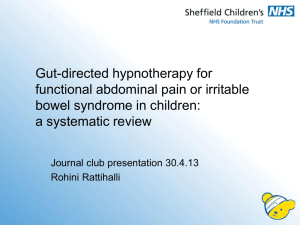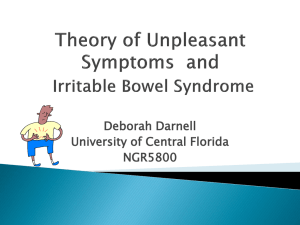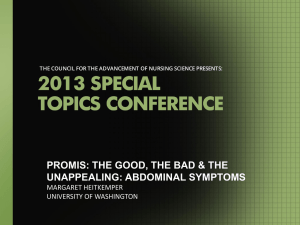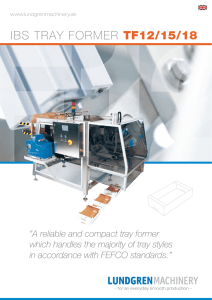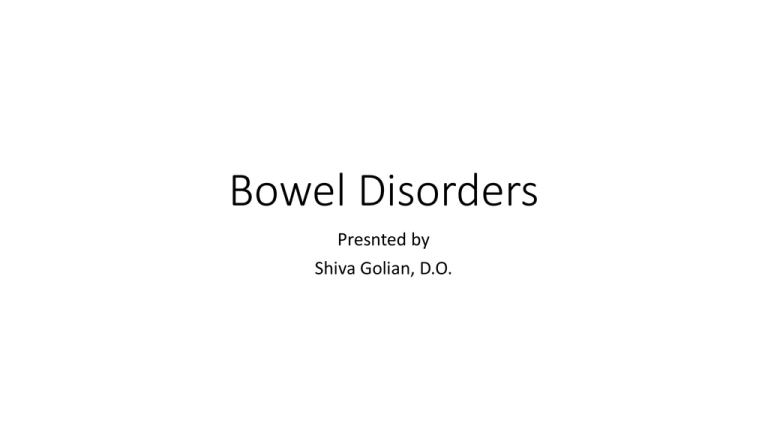
Bowel Disorders
Presnted by
Shiva Golian, D.O.
Disclosures
• None
Objectives
• Identify, diagnose and treat irritable bowel syndrome
• Identify, diagnose and treat fecal incontinence
• Identify, diagnose and treat pruritis ani
Irritable Bowel Syndrome
• Syndrome: group of signs or symptoms that characterize a specific
disorder
• Type of functional GI disorder: chronic disorders of the GI tract in
which an organic or structural lesion responsible for symptom
development cannot be identified
Irritable Bowel Syndrome
IBS
Prevalence and Epidemiology
• Prevalence in North America: 10-15%
• 2:1 female prevalence
• Only 15% of those affected seek medical attention
• Comprises 25-50% of all referrals to the gastroenterologist
• After the common cold, second highest cause of work absenteeism
• Peak prevalence: 3rd and 4th decades
• Decreased prevalence in 6th and 7th decades
• Dx should be made cautiously after age 60
IBS
Etiology
IBS
Pathogenesis
• Altered Gastrointestinal Motility
• No predominant pattern: clustered contractions vs prolonged contractions
• Exaggeration of the normal gut motility
IBS
Pathogenesis
• Visceral Hypersensitivity
• Distention
• Balloon distention sensed at lower volumes
• Rectal distention increased cerebral cortical activity
• Bloating
• Increased abdominal girth
• Impaired transit of intestinal gas loads
IBS
Pathogenesis
• Intestinal Inflammation
• Some studies show an increased number of colonic lymphocytes, mast cells
and plasma proinflammatory interleukins in those with IBS
IBS
Pathogenesis
• Postinfectious
• Associated with bacterial, protozoal, helminthic and viral infections
• Thabane et al (meta-analysis of 18 studies)
• Incidence of postinfectious IBS is 10%
• Odds of developing IBS increase sixfold after acute GI infection
• Risk factors: young age, prolonged fever, anxiety, depression
• Causes of postinfectious bowel symptoms
• Malabsorption: idiopathic bile acid malabsorption
• Increase in enteroendocrine cells/lymphocytes: increased serotonin levels causes
increased GI motility and visceral hypersensitivity
• Antibiotic use
IBS
Pathogenesis
• Change in the fecal microflora
• Is there a role in probiotic use? Need more information
IBS
Pathogenesis
• Small intestinal Bacterial Overgrowth (SIBO)
• Pimental et al
• 78% of 202 pts that met Rome I criteria for IBS had abnormal lactulose breath test
suggestive of bacterial overgrowth
• Very exciting news: this means that IBS can be cured with antibiotics
• Unfortunately, more recent studies have failed to find any association
between IBS and SIBO
IBS
Pathogenesis
• Food Sensitivity
• Food allergy: studies have been conflicting
• Carbohydrate malabsorption: need more investigation
• Gluten sensitivity:
• Those without villous atrophy, presence of serum IgG antigliadin antibodies and
expression of HLA-DQ2 may have a good response to gluten free diet
• Make sure to confirm the absence of celiac disease
IBS
Pathogenesis
• Genetics
• Many studies with twins showing concordance rates ranging from 2-22%
• One study found that having a parent with IBS was a greater independent
predictor of IBS than having an affected twin
• Thus it could be due to social learning
• Genotyping studies
• Perhaps an association with IBS and polymorphisms of serotonin transporter gene
IBS
Pathogenesis
• Psychosocial Dysfunction
•
•
•
•
More lifetime and daily stressful events than control groups
Those with IBS have increased anxiety, depression, phobias and somatization
Positive association between IBS and abuse
Fukudo et al
• Administration of corticotropin releasing factor (CRF – mediator of stress response)
increases abdominal pain and colonic motility in IBS pts
IBS
Diagnostic Criteria
• Manning Criteria
•
•
•
•
•
•
Pain relieved with defecation
More frequent stools at the onset of pain
Looser stools at the onset of pain
Visible abdominal distention
Passage of mucus
Sensation of incomplete evacuation
IBS
Diagnostic Criteria
• Rome III criteria
• Recurrent abdominal pain or discomfort at least 3 days per month in the last 3
months associated with 2 or more of the following:
• Improvement with defecation
• Onset associated with a change in frequency of stool
• Onset associated with a change in form (appearance) of stool
• Symptom onset at least 6 months prior to diagnosis
• **Developed for clinical investigation; no emphasis on postprandial urgency,
abdominal pain, diarrhea
IBS
Subtypes
• IBS with constipation (IBS-C): hard or lumpy stools >/= 25% or
loose/watery stools <25% of BMs
• IBS with diarrhea (IBS-D): loose or watery stools >/=25% or
hard/lumpy stools <5% of BMs
• Mixed IBS (IBS-M): hard/lumpy stools >/=25% or loose/watery stools
>/=25% of BMs (most common group)
• Unsubtyped IBS: insufficient abnormality of stool consistency to meet
the above subtypes
Diagnosis
History
• 2 most common complaints
• Abdominal pain
• Required for diagnosis of IBS
• Should be temporally related to defecation in some way
• Location of pain varies from person to person, but is consistent over time in the
individual
• Altered bowel habits
• But also remember bloating
• Remember – these pts have an altered tolerance to normal amounts of distention
Diagnosis
History
• Be careful of alarm symptoms or “red flags”
• Rectal bleeding
• Nocturnal/progressive abdominal pain
• Weight loss
• Ask about travel history
Diagnosis
Physical
• PE generally WNL
• Abdominal exam
• Tenderness – generally the LLQ
• Should not have any rebound or guarding
Diagnosis
• Good history and physical exam
• Routine labwork (normal in IBS pts)
•
•
•
•
•
CBC
Chemistries
ESR
Stool samples for those with diarrhea
TSH for those with constipation
• History with chronic symptoms, normal PE, normal labwork: accuracy
of diagnosis is 95-97%
Diagnosis
• Colonoscopy
•
•
•
•
•
•
•
Caucasians 50 or older
African Americans 45 or older
Strong family history of colorectal cancer or inflammatory bowel disease
Those with anemia
Those with stool WBCs
Those with alarm symptoms
Those with abnormal labwork
• Diagnosis of exclusion
Treatment
• No cure
• Treatment focused on symptom relief
• Must have a good therapeutic relationship
• Kaptchuck et al
• Pts with positive relationship with their healthcare provider have significantly more
improvement
• Patient education
• Chronicity of syndrome
• Normal life span
Treatment
• Dietary
•
•
•
•
•
•
•
Efficacy of dietary modification not well established
Lactose
Exclusion of gas-producing foods
Food allergy testing: not well studied
Gluten sensitivity
Carbohydrate malabsorption: not enough large studies
Fiber: efficacy not proven
Treatment
• Physical activity: potential benefit
• Psychosocial therapies
• May be beneficial in those with IBS symptoms associated with stressors
• Benefits are controversial
Treatment
• Pharmacotherapy
• Antispasmodic agents
•
•
•
•
Dicyclomine (Bentyl)
Hyoscyamine (Levsin, Levbid, NuLev)
*Chlordiazepoxide/clidinium (Librax)
* Phenobarbital/hyoscyamine/atropine/scopolamine (Donnatal)
Treatment
• Pharmacotherapy
• Antidepressants
• May be beneficial in those with neuropathic pain
• TCAs have anticholinergic properties which help to slow intestinal transit time (helps
with IBS-D)
• Improvement in pain with TCAs occurs at lower doses than doses used for treatment of
depression
• TCAs to try: Amitriptyline (Elavil), imipramine (Tofranil), nortriptyline (Pamelor),
desipramine (Norpramin)
• Be careful with those with IBS-C
• Other meds: paroxetine (Paxil), fluoxetine (Prozac), sertraline (Zoloft)
Treatment
• Pharmacotherapy
• Antidiarrheal agents
• Loperamide (Imodium) – effective for tx of diarrhea, but not for tx of global IBS
symptoms or abdominal pain
• Alosetron (Lotronex)
•
•
•
•
5-HT3 receptor antagonist
Used in females with IBS-D
Complications: ischemic colitis, severe constipation
FDA has brought this back under tight control
Treatment
• Pharmacotherapy
• Tegaserod (Zelnorm)
• 5-HT4 receptor agonist
• Used in IBS-C
• Removed from market d/t cardiovascular side-effects
• Lubiprostone (Amitiza)
• Locally acting chloride channel activator
• Best to use with for those with IBS with severe constipation where other approaches
have failed
• Used in IBS-C
Treatment
• Pharmacotherapy
• Linaclotide (Linzess)
• Guanylate cyclase agonist – stimulates intestinal fluid secretion and transit
• Used for IBS-C
• Antibiotics
•
•
•
•
Rifaximin – a nonabsorbable antibiotic
Improvement in bloating, abd pain, or altered bowel habits
Used in IBS without constipation
Benefits may be due to suppression of gas producing bacteria in colon
Treatment
• Alternative therapy
•
•
•
•
•
Peppermint oil
Probiotics
Acupuncture
Enzyme supplementation
Hypnotherapy
Fecal Incontinence
Fecal Incontinence
Background
• In 1988
• Cost of adult diapers thought to exceed $400 million annually
• Second leading cause of nursing home placement
• Definition
• Continuous/recurrent uncontrolled passage of feces (>10ml) for at least 1
month in someone > 3-4 yrs old
Fecal Incontinence
Epidemiology
• Varies greatly depending on age, definition, setting: 1-24%
• This may be an underestimation
• Occurs in about 47% of nursing home residents
Fecal Incontinence
Risk Factors
• Increasing age
• Occurs in 15% of those >/= 70
• Poor general health
• Physical limitations
• COPD
• IBS
• Urinary incontinence
• Chronic diarrhea
• In women: depression and white race
Fecal Incontinence
• Anatomic considerations
Fecal Incontinence
Fecal Incontinence
Pathophysiology
• Dysfunction of anal sphincters
• Abnormal rectal compliance
• Decreased rectal sensation
• Combination of the above
Fecal Incontinence
Pathophysiology
• Dysfunction of anal sphincters
• Vaginal delivery
• Anal sphincter tears
• Trauma to pudendal nerve: may cause incontinence years after delivery
• Risks:
• Forceps
• High birth weight infant
• Long second stage of labor
• Occipitoposterior presentation of fetus
Fecal Incontinence
Pathophysiology
• Dysfunction of anal sphincters
• Surgical trauma
• Anal fistula
• Hemorrhoidectomy
• After injection of botulinum toxin
• Diabetes mellitus
• Reduced internal anal sphincter resting pressure
• Can be due to autonomic neuropathy
Fecal Incontinence
Pathophysiology
• Decreased rectal compliance
•
•
•
•
Ability of rectum to store fecal debris is reduced
Leads to increased frequency and urgency
Leads to incontinence even if sphincter function is normal
Common conditions
• Ulcerative colitis
• Radiation proctitis
Fecal Incontinence
Pathophysiology
• Impaired rectal sensation
•
•
•
•
•
DM
MS
Dementia
Meningomyelocele
Spinal cord injury
Fecal Incontinence
Pathophysiology
• Fecal impaction
• Elderly
• Constant inhibition of internal anal
sphincter
• Overflow incontinence
Fecal Incontinence
• History
• Differentiate true incontinence from frequency and urgency
• History of:
•
•
•
•
•
•
Prior vaginal delivery
Anorectal surgery
Pelvic irradiation
Diabetes
Neurologic disease
Do symptoms occur with a background of diarrhea?
Fecal Incontinence
• Physical exam
• Appropriate inspection of the perianal area
• Fistula, prolapsing hemorrhoids, rectal prolapse
• Anocutaneous reflex (anal wink sign)
• Absence suggests nerve damage
• Digital Rectal Exam
• Mass, fecal impaction
• Pt should be instructed to bear down and then squeeze against the finger
Fecal Incontinence
Diagnostic Procedures
• Anorectal manometry
• Measures pressures
• Decreased resting pressure suggests isolated IAS dysfunction
• Decreased squeeze pressure suggests isolated EAS dysfunction
Fecal Incontinence
Diagnostic Procedures
• Endorectal ultrasound/MRI
• Good for identifying structural abnormalities of the anal sphincters, rectal
wall, puborectalis muscle
• Ultrasound much more economical
• Findings correlate well with manometric findings
Fecal Incontinence
Diagnostic Procedures
• Defecography
• Barium paste is instilled into rectum
• Pt is then seated on a radiolucent commode and films are taken at rest and
during straining and defecation
Fecal Incontinence
Treatment
• Medical therapy
• Aimed at reducing frequency of stool and improving consistency of stools
• Bulking agents
• Antidiarrheal drugs: Loperamide and Lomotil
• Loperamide also increases internal anal sphincter tone
•
•
•
•
Anticholinergics: hyoscyamine
TCAs: may help with idiopathic fecal incontinence
Those with mental dysfunction/physical debility: regular defecation program
Stool impaction: disimpaction and bowel regimen to prevent further
impaction
Fecal Incontinence
Treatment
• Biofeedback
•
•
•
•
Painless and non-invasive
Retrains the pelvic floor and abdominal wall musculature
Rates of success: 38-100%
Based on the available evidence, the role of biofeedback is unsettled
Fecal Incontinence
Treatment
• Surgery
•
•
•
•
Anterior overlap repair: for obstetric damage
Gracilis neosphincter: when anal sphincter muscles are irreversible damaged
Synthetic sphincter device: for pts with anal leakage
Colostomy: when all other txs failed
Fecal Incontinence
Treatment
• Sacral nerve stimulation
• Effective in those with neurological disorders
• Electrode is inserted into the S3 sacral foramen
• The electrode then provides low grade stimulation via an implanted stimulator
• Improvement in both resting and squeeze pressures
• Drawback: follow up studies show high rate of revision (41%)
• Infection, electrode displacement, electrode breakage, increased impedance, pain,
battery depletion, partial or total loss of efficacy
Fecal Incontinence
Treatment
• Dextranomer-hyaluronic acid (Solesta)
• Four 1 ml injections into deep submucosa
• Shows promise
Pruritis Ani
Pruritis Ani
• Anal itching
• Most common anorectal symptom presenting to dermatologist
• Rich nerve supply to perianal area is thought to be the primary reason
for sensitivity to potential irritants
Pruritis Ani
• Frequency
• Affects 1-5% of population
• Sex: M>F
• Age: 20-40 years (rare in elderly)
Pruritis Ani
• Secondary causes
• Anorectal conditions: Rectal prolapse, hemorrhoids, fistula in ano, fissure,
skin tag, mucosal extropion, villous adenoma, hidradenitis suppurativa
• Infections: HSV, condyloma acuminata, gonorrhea, syphilis, TB, erythrasma,
fungal infection
• Surgical procedures: those involving weakening of anus causing seepage
Pruritis Ani
• Secondary causes:
• Skin disorders: contact dermatitis, psoriasis, eczema, lichen planus, lichen
sclerosis et atrophicus, lichen simplex leukiplakia
• Neoplastic disorders: Paget’s disease, Bowen’s Disease
• Ingested drugs: mineral oil, colchicine, quinidine, anabolic hormones,
antibiotics (secondary diarrhea)
Pruritis Ani
• Secondary cause:
• Systemic disorders: obstructive jaundice, uremia, diabetes
• Primary (idiopathic) cause
• Once all secondary causes are ruled out
• Mostly diet induced:
• Coffee is most common agent
• Tea, cola, chocolate, beer, milk, tomatoes, citrus fruits, vitamin C, nuts, cheese, milk
products, alcohol, smoking
Pruritis Ani
• Primary causes
• Compulsive anal cleaners
• Farouk manometry results:
• Internal sphincter pressure decrease was greater in pruritis patients compared with
control patients
• Prolonged duration of internal sphincter relaxation after rectal distention
• Symptoms of seepage
Pruritis Ani
• Examination
• Skin changes may be staged
•
•
•
•
Stage 0: skin normal
Stage 1: skin red and inflamed
Stage 2: white, lichenified skin
Stage 3: coarse ridging of skin with ulceration superimposed on lichenification
Pruritis Ani
• Stage I (mild): No lesion seen at
inspection of anal verge but the
patient finds palpation and/or
anoscopy painful, and other anal
lesions have been excluded
Pruritis Ani
• Stage 2 (moderate): Red dry skin
only, at times weeping skin with
superficial round splits and
longitudinal superficial fissures
Pruritis Ani
Pruritis Ani
• Stage 3(severe): Reddened,
weeping skin, with superficial
ulcers and excoriations disrupted
by pale, whitish areas with no
more hairs
Pruritis Ani
Pruritis Ani
• Stage 4 (chronic): whitened,
thickened, dry, leathery, scaly
skin with no hairs and no
superficial ulcers or excoriations
Pruritis Ani
• Examination
• Distribution
• Symmetrical: diet induced
• Asymmetrical: infection
Pruritis Ani
• Treatment
• Specific treatment for any secondary causes with
antifungal/antibiotic/antiparasitic
• Add bulking agent (e.g. metamucil) absorbs liquid from stool and helps
diminish seepage associated with minor int sphincter weakness
• Stop the offending drug
• Stop using any soaps, topical antipruritics, etc to perianal skin
Pruritis Ani
• Treatment
•
•
•
•
•
Stop scratching the skin
After BM bathe or wash area using water without soap
Pat skin dry with cotton towel – do not rigorously rub
No scented toilet paper
Loose underclothes
Pruritis Ani
• Treatment
• Use elimination diet to identify etiologic agent (may take 2-3 wks for itching
to stop after agent is stopped)
• May use bulb tip syringe to flush out any fecal residue after BMs
• Apply small cotton ball on anal canal to absorb any further seepage
Pruritis Ani
• Treatment
• Steroidal anti-inflammatory cream with second layer of barrier cream
(calamine, calmoseptine, zinc oxide)
• Do not exceed 3 wks of steroid use to prevent atrophy
• If all treatments fail, skin bx and consider referral to dermatologist
Thank You

